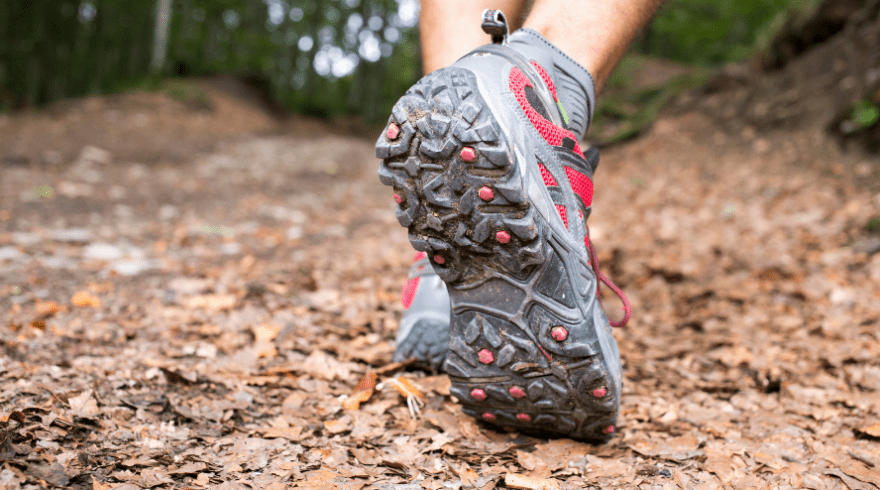
Remember everyone’s foot is different and what works well for one may be terribly unsuitable for another.
Things to consider before you start shopping:
Boot vs. Shoe?
- Hiking shoes and soft soled boots are lighter, have a more flexible sole and are often preferred for day hikes and for those who carry a minimum pack weight (less than 12kg including consumables).
- Hard soled boots are built stronger to support a load when carrying a heavy backpack, and are often preferred for longer and multi day hikes with those carrying heavier packs.
- Boots will provide more ankle support, so if you know your ankles are your weak point then you might prefer a boot even for shorter hikes.
Trail Runners?
- Trail runners have become increasingly popular amongst hikers and especially long-distance hikers over the recent years. Fortunately, many reputable trail running brands have adapted to this and create some fantastic trail running options with stiffer soles and more support for hikers.
- We would not advise even considering trail running shoes if you are not an ultralight hiker - you will not have the support you need if you have a heavy pack weight.
- Trail runners often will feel similar to your everyday runners, and should not be ruled out for a beginner hiker starting with day walks.
Waterproofing vs. breathability?
A waterproof hiking shoe is lined with a membrane (usually Goretex) to stop water from soaking into the shoe. The membrane is designed to be breathable, but is not anywhere near as breathable as a non-waterproof shoe.
You can choose to forego the breathability in exchange for dry feet - but be warned: if the rain is heavy enough and consistent enough, you will not keep your feet dry, and the membrane makes it very difficult to dry them out overnight. Another factor to take in is the fact that feet are rather sweaty things, and in a waterproof shoe your breathability is diminished quite a bit, which may result in damp feet, regardless of the weather.
So, decide whether you value breathability over waterproofing, and understand the risks of both.
Synthetic vs leather/nubuck?
COMFORT:
- Leather will require a breaking in period, as will nubuck but not quite as much. Leather boots will often mould to your foot quite nicely over time.
- Synthetic can often feel "good" straight away as they are usually a little less rigid.
BREATHABILITY:
- As a natural fibre leather as a skin, is more breathable than synthetic, however, these days synthetic fibres are manipulated in clever ways and in many instances you might find a synthetic shoe to have better breathability that leather.
WEIGHT:
- Synthetic will usually be lighter than leather (but its marginal).
LOOK:
- Some prefer the aesthetics of a leather boot which will often look more “traditional” and minimal than a synthetic boot which will often be made to look more 'technical'.
DURABILITY:
- When it comes to durability its on par, both can last a while and you may find you have to retire them due to the sole wearing out rather than anything been wrong with the upper.
MAINTENANCE:
- Leather boots require some care if you want them to last, especially after been exposed to moisture for long periods.
Let's go shopping!
Do your research
Jump online and read what other people have had to say about various boots and shoes for hiking. There are thousands of reviews available, and most reputable hiking store in Perth will stock the leading brands.
Remember to take your own hiking socks when you visit a store to try on hiking shoes, and trim those toenails!
Fitting a hiking shoe:
- You will often need to buy hiking shoes/boots a half to full size bigger than usual, as your feet will swell when hiking, especially if you are planning longer or multi day hikes.
- Consider going for a ‘wide fit’, some women’s shoes are now available in wide, but you can also cross over to mens if the sizing is suitable.
- Unless you have exceptionally narrow feet, choose footwear with a wide toe box and plenty of length, so that your toes are not restricted.
- Make sure they don’t slip on your heal when you walk. Standing still and lifting one heel off the ground will help you to see if they are slipping.
- Pay attention to the inner sole contours of a shoe or boot as these will hold your foot in place and prevent it from sliding forward, cramping your toes and causing issues with toenails.
- Lacing your footwear firmly will also help prevent your foot from slipping forward, however lacing your boots too tightly will reduce circulation in your feet causing a tingling sensation which will cause problems over time.
- Experiment with different lacing techniques to get a comfortable fit.
- Take your time and never feel pressured by a busy sales person. If you are not 100% sure, keep looking or come back later when the store is not so busy and staff have more time to spend with you!
Tips:
- If you are struggling with getting just the right fit talk to a sales representative about a hike-specific insole like Superfeet.
- If you have decided waterproof shoes are for you, and you’re likely to see some wet weather then consider purchasing some waterproof gaiters - these will slow down the water creeping in through the top of your shoes.
- Outdoor Gear Lab is a great place to start for the most up to date and thorough reviews on Outdoor Gear.
- Paddy Pallin stock an excellent array of hiking footwear
Final Points:
- Even with the right boot or shoe, other factors like posture and pack weight distribution will affect your footwear comfort.
- Choosing the right pack, fitting and loading it correctly will help.
- The use of hiking poles will also help maintain good posture and in turn, improve foot comfort.
- Make sure you keep your toenails trimmed, especially during extended hikes of several weeks.
Photo courtesy of Off The Beaten Track

